Try This Tasty Salmon Salad Recipe Today
Freshly caught salmon shines in this vibrant salad recipe that bursts with color and flavor.
The delicate fish pairs perfectly with crisp greens and zesty dressing.
Packed with omega-3 fatty acids, this dish offers a nutritious and delightful meal.
Light and refreshing, the salmon salad brings restaurant-quality elegance to your home kitchen.
Each bite delivers a harmonious blend of textures and tastes that dance on your palate.
The combination of tender salmon and bright, crunchy vegetables creates a truly satisfying experience.
You’ll fall in love with this simple yet sophisticated salad that comes together in minutes.
Prepare to savor every healthy, delicious forkful of this salmon sensation.
What Makes This Salmon Salad So Refreshing
The Core Ingredients Behind the Salad
Protein Base:Aromatic Vegetables:Dressing Components:Assembling a Flavorful Salmon Salad
Step 1: Chop Fresh Ingredients
Gather your cutting board and knife to dice red onion and celery into tiny, uniform pieces.
Prepare the salmon by carefully flaking freshly cooked salmon or draining canned salmon.
Remove any skin or tiny bones for a smooth texture.
Transfer the salmon, onion, and celery into a spacious mixing bowl.
Step 2: Whip Up Zesty Dressing
In a separate bowl, combine mayonnaise, freshly squeezed lemon juice, chopped dill, salt, and black pepper.
Whisk the ingredients until they blend smoothly.
Taste the dressing and adjust the seasoning to your preference.
An extra splash of lemon juice can brighten the overall flavor profile.
Step 3: Gently Blend Salad
Pour the prepared dressing over the salmon mixture.
Use a gentle folding technique to mix the ingredients, maintaining the salmon’s delicate texture.
Avoid mashing or breaking down the fish pieces.
Ensure each ingredient is evenly coated with the creamy dressing.
Step 4: Chill And Enhance Flavors
Cover the salmon salad and refrigerate for 15-20 minutes.
This resting time allows the flavors to meld together, creating a more harmonious and delicious dish.
Serve chilled as a refreshing appetizer or light meal.
Little Fixes to Elevate the Salad
Chill, Store, and Refresh Leftover Salad
Sides That Pair Nicely With Salmon Salad
Ways to Customize This Salmon Salad
FAQs
Look for bright, uniform color without dark spots or brown edges. Fresh salmon should smell like the ocean, not fishy. Ask your fishmonger about the catch date and choose salmon with clear, bright eyes if buying whole fish.
Yes! Greek yogurt makes an excellent lighter substitute. It provides similar creaminess with fewer calories. Use the same measurement as mayonnaise in the original recipe.
Wild-caught salmon like sockeye or king salmon offer richer flavor. Canned salmon works great too. If using fresh, choose center-cut pieces for most consistent texture and easiest flaking.
Absolutely! This salmon salad stays fresh in the refrigerator for 2-3 days when stored in an airtight container. The flavors actually improve after sitting for a few hours, making it perfect for make-ahead lunches.
Print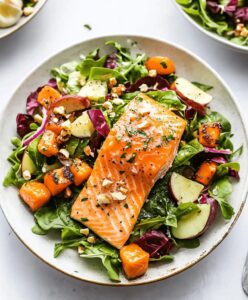
Salmon Salad Recipe
- Total Time: 35 minutes
- Yield: 4 1x
Description
Mediterranean salmon salad combines fresh ocean flavors with zesty herbs and crisp vegetables. Mediterranean cuisine shines through this light, protein-packed dish that invites you to savor each refreshing bite.
Ingredients
Main Protein:
- 15 ounces (425 grams) salmon (canned or freshly cooked)
Vegetables:
- 1/2 small red onion, diced small
- 1 stalk celery, diced
Seasonings and Dressing:
- 1/2 cup (120 milliliters) mayonnaise (light or regular)
- 1 tablespoon (15 milliliters) lemon juice
- 1/2 tablespoon (7.5 milliliters) fresh dill (or 1 teaspoon (5 milliliters) dried dill)
- 1/2 teaspoon (2.5 milliliters) salt
- Black pepper, to taste
Instructions
- Prepare the foundational components by finely chopping red onion and celery into uniform, delicate pieces ensuring consistent texture throughout the salad.
- Process the salmon carefully, draining canned variety thoroughly or flaking freshly cooked salmon into gentle, bite-sized fragments. Ensure no bones or skin remain if desired.
- Transfer salmon, onion, and celery into a spacious mixing vessel, maintaining a light, airy composition that preserves the delicate protein structure.
- Craft the dressing by whisking mayonnaise, zesty lemon juice, fragrant fresh dill, precise salt measurements, and cracked black pepper in a separate container.
- Taste the dressing, adjusting seasoning with additional lemon juice to enhance brightness and create a harmonious flavor profile.
- Gently fold the dressing into the salmon mixture, using careful, delicate motions to prevent breaking down the salmon’s tender texture.
- Refrigerate the salad for 15-20 minutes, allowing flavors to meld and intensify, creating a more complex and refined taste experience.
- Serve chilled, ensuring the salad maintains its light, fresh characteristics and optimal temperature for maximum enjoyment.
Notes
- Customize salmon choice between canned or freshly cooked, ensuring maximum flavor and texture flexibility.
- Cool salmon completely before mixing to maintain delicate flake structure and prevent soggy texture.
- Enhance nutritional value by adding extra chopped herbs like parsley or chives for vibrant color and fresh taste.
- Prep Time: 15 minutes
- Cook Time: 20 minutes
- Category: Lunch, Dinner, Appetizer
- Method: Mixing
- Cuisine: American
Nutrition
- Serving Size: 4
- Calories: 250
- Sugar: 1g
- Sodium: 450mg
- Fat: 15g
- Saturated Fat: 2g
- Unsaturated Fat: 10g
- Trans Fat: 0g
- Carbohydrates: 6g
- Fiber: 1g
- Protein: 24g
- Cholesterol: 70mg

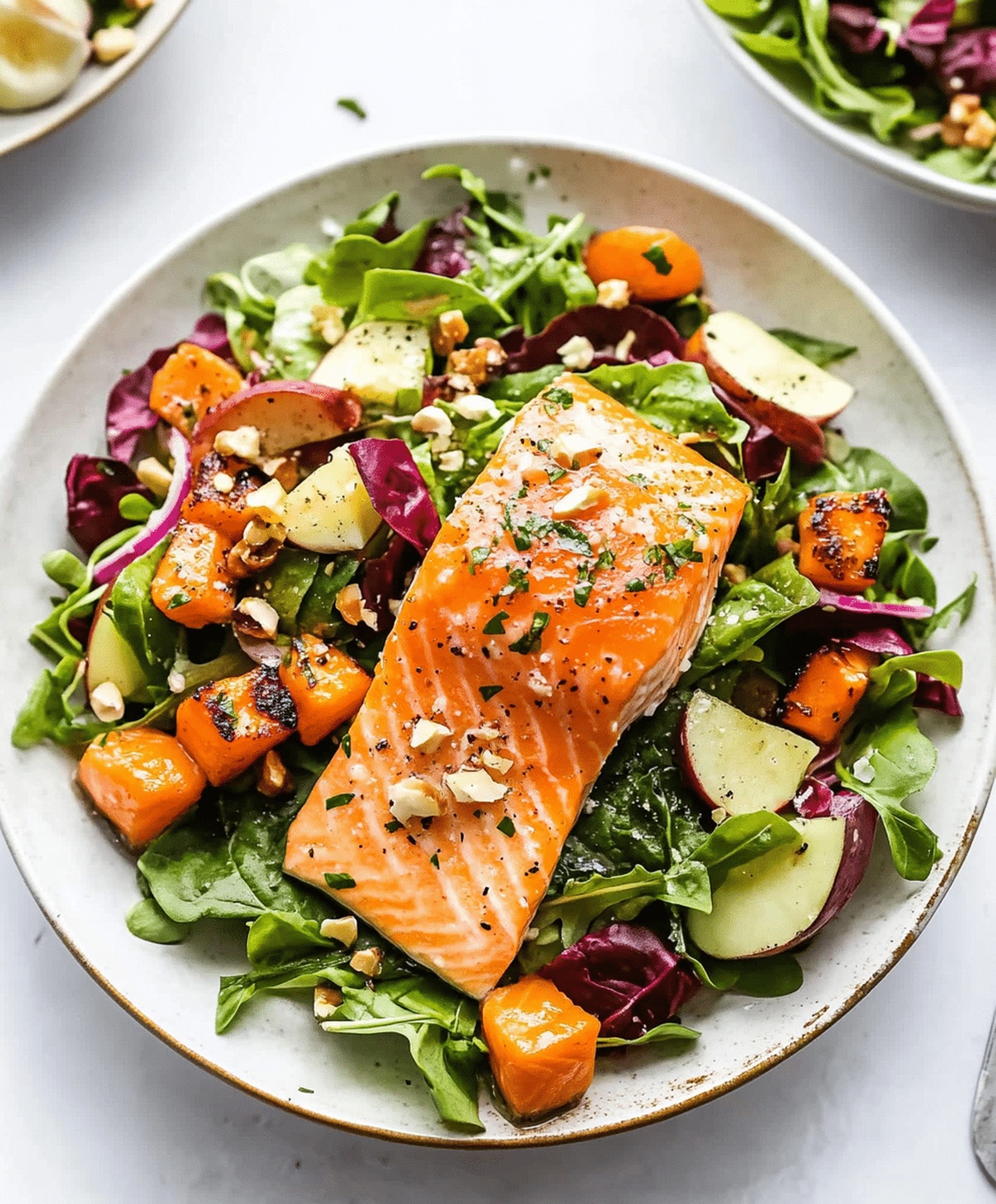
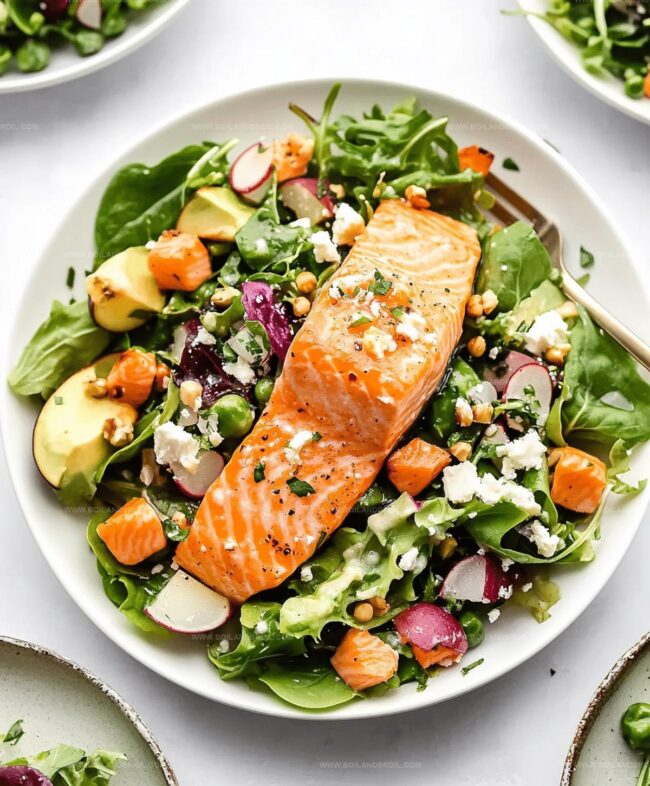
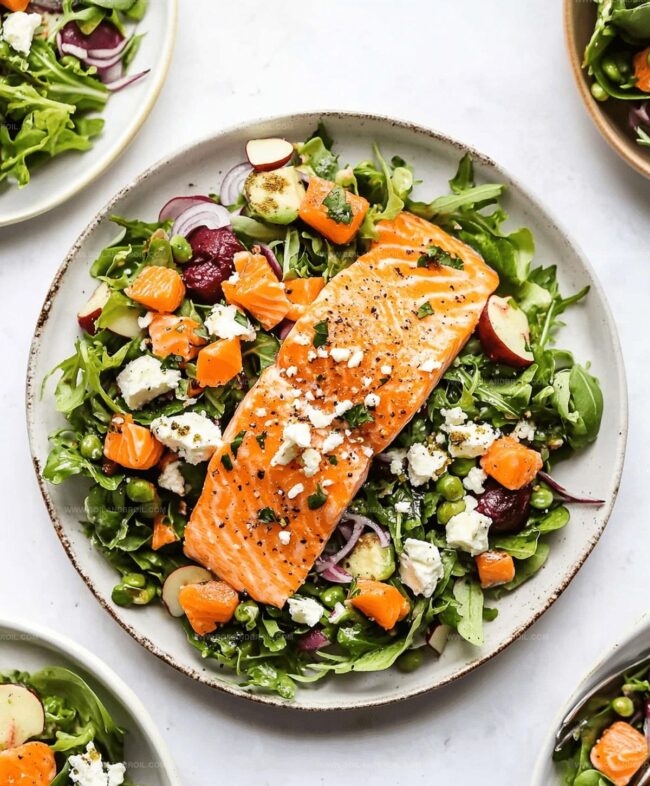
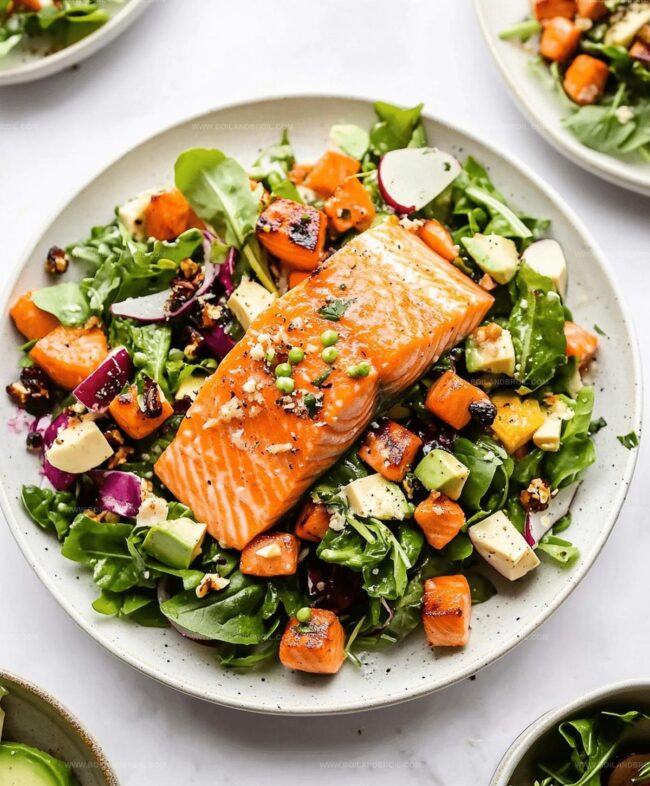
Clara Thompson
Recipe Developer & Culinary Educator
Expertise
Developing accessible single-serving recipes, Food writing and content creation, Plant-based and allergen-friendly cooking, Culinary education and workshop facilitation
Education
Oregon Culinary Institute (Portland, OR)
Diploma in Culinary Arts
Specialized in plant-based cooking and sustainable kitchen practices.
Portland Community College
Certificate in Food Writing and Media
Focused on recipe writing, food photography, and digital content creation.
Clara’s food journey began with a curiosity for color, texture, and ingredients pulled straight from the garden. Her background in plant-forward cooking and creative writing gives her a unique edge – she makes healthy, flavorful food feel inviting, not intimidating.
She specializes in meals that work for busy lives and different diets, all without sacrificing taste. Clara’s voice comes through in every recipe she writes – clear, kind, and encouraging.